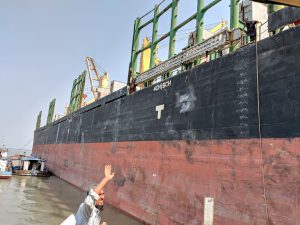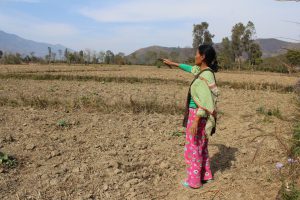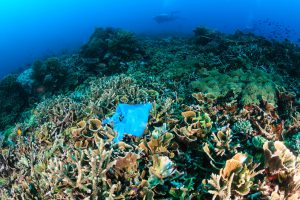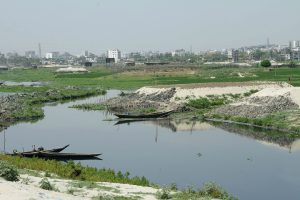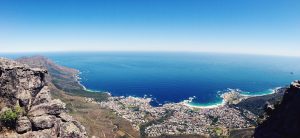Laila Khatun was carrying an armful of mud from the river. “Come, I’ll show you,” she said when asked why. The large hut where she lived with her joint family was next door.
There was a mound of mud next to the hut, to which she added her armful, straightened up, and said, “We have to get enough mud so that our husbands can make a high platform. Then they’re going to shift our hut to the top of the platform.”
Their hut was now on top of a bund, at least 10 feet above the Shela river which met the Bay of Bengal in just another kilometre or so. Why did they have to raise their hut higher?
“You don’t know what happens at high tide,” 20-year-old Laila said scornfully. “The water comes in, everything at home gets spoilt. This year, it has become impossible to live in this house. For hours, we have to sit on our beds and wait for the water to go down. We can’t do any cooking. All the fuelwood gets damp even if we keep it away from the water. And it will get far worse during the monsoons. We have to raise our home before the rains arrive.”
Standing under the already-hot February sun and watching the quiet noonday river at low tide, it was not easy to imagine tides rising so high regularly. “If you want to see how far the water rises, go taste the water in the pond behind,” said Laila’s sister-in-law Rumi Khatun.
It was salty sea water.
So, what do they do for drinking water? “There’s one pond in our village, Joymonigola, where the water is not so bad,” Rumi said. “All of us use it.”
At the southern end of the Sundarbans near the port of Mongla in Bangladesh, Joymonigola is known as a village under imminent threat of inundation due to sea level rise, caused by climate change. But the fate of hundreds of other villages that ring the Sundarbans – the world’s largest mangrove forest straddling Bangladesh and India – is hardly better.
See: Rising sea swamps island along Bengal coast
There was a time when the Ganga-Brahmaputra-Meghna delta in Bengal was known for the deep green of paddy fields stretching to the horizon. Now, at the toe end of the delta in Bangladesh, prawn and crab farms stretch to the horizon. The water and the soil have turned too salty for even salt-tolerant paddy varieties, and this form of aquaculture is the only form of livelihood possible.

Next door to Laila Khatun’s house, Kishore Mandal is smoothing out the top of the four-foot-high platform he has built for the same purpose. “This is good sticky mud,” he says, when asked if the platform will withstand the water that may seep in during high tides. “I’m hoping it won’t crumble.”
“What can we do if it does crumble?” his wife Tripti asks as she shores up the side of the platform with more mud. “We don’t have the money to build a pucca (brick and mortar) house. All we’re trying to do is to keep our belongings above water. Last year, all the schoolbooks of my son were ruined by salt water when a high tide came in the middle of the night. If we don’t raise our hut this year, even the solar panel on our roof may be drowned.”
Kishore spent BDT 32,000 (USD 385) to buy the solar panel, fittings, wires, and four bulbs at Bagerhat two years back. “It is very important,” he says. “Thanks to the light, our son can study at night. Many of the homes in our village have solar lights now.”
Is Kishore a farmer? “I was,” he replies. “But now nothing grows on this soil – no paddy, no vegetables, nothing. The soil is too salty; the water available for irrigation is also too salty. So, like everyone else here, I have moved to prawn and crab farming.”
How long has this been going on? “It started getting bad about 20 years back,” says Kishore. “Around the same time, some people in the village started farming prawns. They made a lot of money, so most of us started farming prawns as well.”
“In the beginning, many of us used to farm both paddy and prawns. But for the last ten years or so, the paddy doesn’t grow. It got worse after Cyclone Aila (May 2009). So now we are all farming prawns. But it’s difficult. Prawns catch viruses very easily, and all of them can die by the time you go to the market and get the medicine. All the money you have put in can get wiped out.”
“Then somebody said crabs are hardier than prawns and fetch a better price. So, for the last few years, we have started farming crabs also. But they are just as prone to virus attacks. I don’t know what we’ll do if the crabs fail us.”
See: Migration always good? There’s no straight answer
Tripti says in an undertone, “We can go to India.”
“I don’t want to leave our ancestral home,” answers Kishore. “My grandparents stayed back when the country was divided (in 1947). But now we may be forced to go.”
With land too ruined by the rising sea, migration – no matter how difficult – seems the only way out for these families already living on the brink.
![<p>In Joymonigola village near the port of Mongla in southern Bangladesh, Tripti Mandal shores up the four-foot-high mud platform that husband Kishore is completing, so that they can raise their hut (in the background), hopefully above the high tide level this monsoon [image by: Joydeep Gupta]</p>](https://dialogue.earth/content/uploads/2018/03/IMG_4022.jpg)

